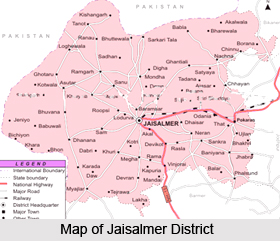 Administration of Jaisalmer district is carried out by District Magistrate and Collector, who is the head of district administration. Jaisalmer is the largest district (in area) of the Jodhpur Division, and administrative control and monitoring of the district is done by the Collector with the assistance of one Additional District Magistrate and one Additional District Magistrate (Development) who is also the CEO of the Zila Parishad. For administration and development, the district is divided into three sub-divisions i.e. Jaisalmer, Pokaran and Fatehgarh and three tehsils, i.e. Jaisalmer, Pokaran and Fatehgarh. The developmental activities of the district are being looked after by three Panchayat Samities, i.e. Jaisalmer, Sam and Sankra. There are a total of 744 villages (37 uninhabited 707 inhabited revenue villages) and 128 Gram panchayats.
Administration of Jaisalmer district is carried out by District Magistrate and Collector, who is the head of district administration. Jaisalmer is the largest district (in area) of the Jodhpur Division, and administrative control and monitoring of the district is done by the Collector with the assistance of one Additional District Magistrate and one Additional District Magistrate (Development) who is also the CEO of the Zila Parishad. For administration and development, the district is divided into three sub-divisions i.e. Jaisalmer, Pokaran and Fatehgarh and three tehsils, i.e. Jaisalmer, Pokaran and Fatehgarh. The developmental activities of the district are being looked after by three Panchayat Samities, i.e. Jaisalmer, Sam and Sankra. There are a total of 744 villages (37 uninhabited 707 inhabited revenue villages) and 128 Gram panchayats.
With the ushering in of the Panchayati Raj, three block Panchayat Samities namely Jaisalmer, Sam (headquarters Jaisalmer) and Sankra (headquarters Pokaran) having a total of 128 Gram Panchayats have been functioning in the district and are governed by the Zila Parishad under the Chairmanship of Zila Pramukh and administratively supervised by the District Collector who is ex-officio District Development officer. The aim of the Panchayat Samities is to promote development activities at the block level and oversee implementation with regard to some of the schemes. After the re-set of Panchayati Raj, Gram Panchayats, Panchayat Samities and Zila Parishad have been empowered to work independently keeping in view the requirement and necessity of the developmental setup in their respective areas.
Rural India which encompasses three fourths of the country`s population is characterized by low income levels, inadequate to ensure a quality of life compatible with physical well being. The Ministry of Rural Development, spearheading the frontal attack on rural poverty, through its various programmes endeavoured to reach out to the last and most disadvantaged sections of society, provide them with avenues of employment, be it self-employment or wage-employment, and to improve infrastructure relating to their life support systems. To strengthen the Panchayti Raj Institution, the Government has merged DRDAs into Zila Parishad since 30th August 2003.
Implementation of Development Plans and Programmes
Rural Development and poverty alleviation programmes are implemented on a decentralized basis throughout the country. The central Government Ministry of Rural Development has been implementing programmes in the rural areas for which it releases central share of funds for policy formulation, overall guidance, monitoring and evaluation of the rural development programmes. At the state level, Secretary, Rural Development of the state Government is the overall in charge for implementation. At the district level the District Rural Development Agency (DRDA) / Zila Parishad is responsible for the implementation of the rural development programmes. The governing body of the DRDA includes the Members of Parliament (MPs), Members of Legislative Assembly (MLAs), district level officials of related departments, and representatives of the weaker sections of the society. At the block level the Block Development Officer and at the village level, the Gram Sevaks (Village Representatives) are responsible for the implementation of rural development plans.
DRDA/Zila Parishad, Jaisalmer are working in accordance with the guidelines of the central government and the state government for the execution of various rural development works. Some of the works and plans being executed by these authorities in the district are Sampoorna Grameen Rojgar Yojana (SGRY), MP Local Area Development Programme (MPLAD), MLA Local Area Development Programme (MLALAD), Swarna Jayanti Swarojgaar Yojana (SJSY), Indira Awaas Yojana (IAY), National Social Assistance Programme, and Desert Development Programme, Combating Desertification Programme, Border Area Development Plan (BADP) etc. Besides all these schemes, DRDA is playing an effective role in running Famine Relief Programs also.



















